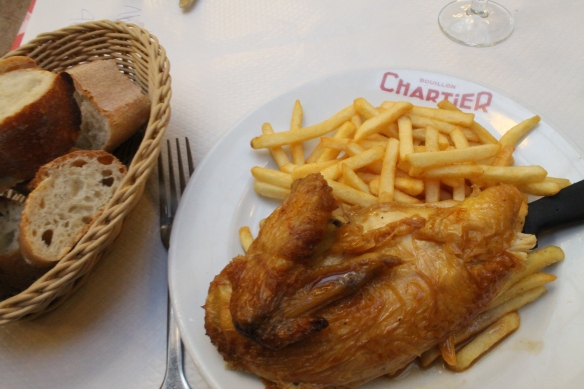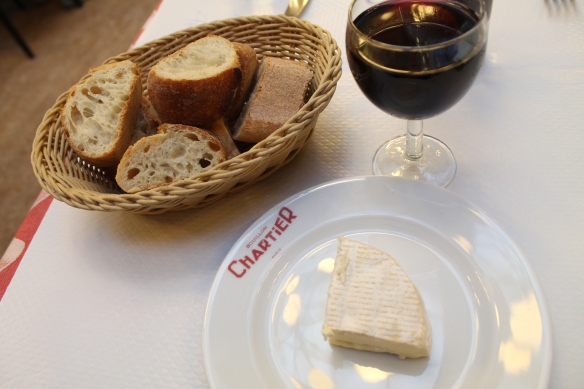


There’s something a little bit decadent about sitting in a half-empty restaurant at 4:30 pm on a Monday sipping a cocktail while waiting for your roast chicken to arrive. Because I’m usually at work at 4:30 pm on a Monday. But today was my RTT day (basically, one day off a month). And the weather was so beautiful I spent most of the day outdoors (a) exploring my old neighbourhood in the 9th arrondissement, (b) popping into Drouot auction house, (c) strolling the picturesque Passages, (d) shopping at La Marelle vintage boutique and buying a pair of fab Carel boots. But all that in another post. For now, let me tell you about Chartier.


Here’s what Courtney Traub wrote on her Go Paris website – First opened in 1896 as “Le Bouillon Chartier”, a cantine for the working classes serving up simple hot dishes comprised of meat and vegetables, Chartier is now a much-coveted address for inexpensive French fare in a gorgeous setting. The restaurant, set near the bustling Grands Boulevards neighborhood, is housed in an imposing turn-of-the-century hall decked out on all sides with large mirrors, wooden panelling and globe lamps. Chartier is as famous for its inexpensive, basic dishes as it is for its congenial, teasing servers wearing traditional black waistcoats and white aprons, who scrawl your orders out on the white paper tablecloths in front of your eyes.

Pros:
•Simple, classic French fare for very reasonable prices
•Unbeatable Belle-Epoque setting
•Friendly, vivacious service and warm ambiance abounds
•Nonstop service all day long, including weekends
•Central location: in close reach of several right-bank attractions and interesting neighborhoods
Cons:
•Reservations not accepted; long lines outside often await
•Quality of food is often rather mediocre
•Not ideal for intimate tete a tetes: tables are often shared with other patrons
•Very few vegetarian and vegan options
OK, so you don’t come here for superlative food, although I must say that everything I ate and drank was delicious. You go for fun, ambiance and low prices. It’s what my mother would call “cheap and cheerful.” It gets very crowded at night, especially on weekends. I went today because it’s in my old neighbourhood and I hadn’t stepped foot in the place for 12 years. And at 4:30 pm it was quiet: a perfect setting in which to sit, take stock of your life, and relax. (hours are non-stop from 11:30 am to midnight, seven days a week)



So go. Drink wine. Eat chicken. Chat with your neighbours (some tables are shared.) Enjoy life.
http://www.bouillon-chartier.com/en/



